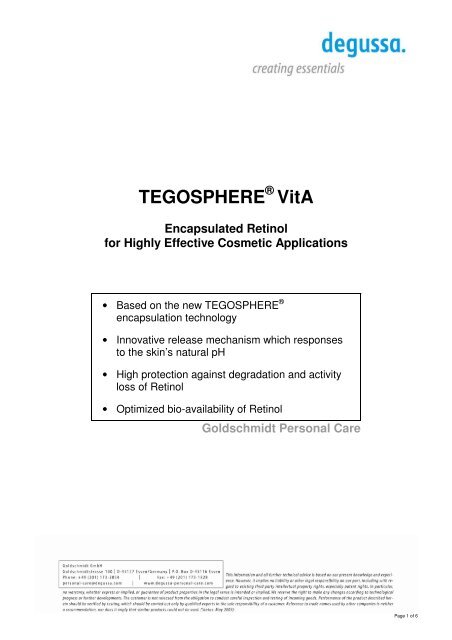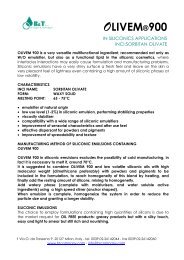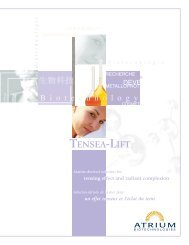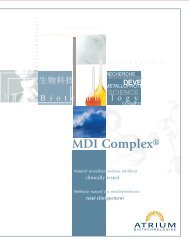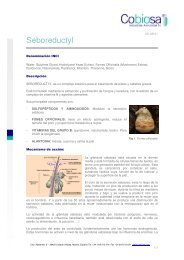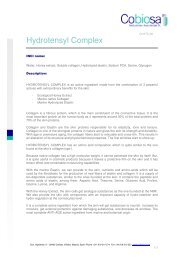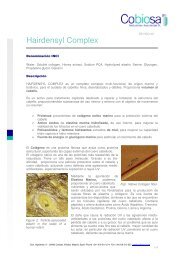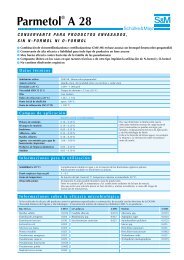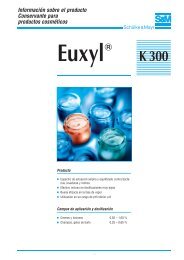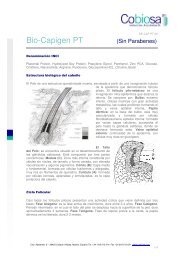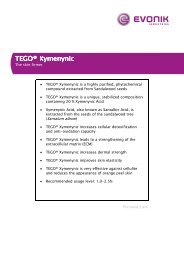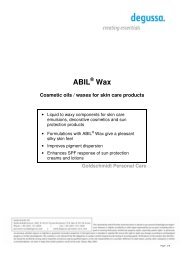TEGOSPHERE® VitA - Quetzal Quimica
TEGOSPHERE® VitA - Quetzal Quimica
TEGOSPHERE® VitA - Quetzal Quimica
You also want an ePaper? Increase the reach of your titles
YUMPU automatically turns print PDFs into web optimized ePapers that Google loves.
TEGOSPHERE ® <strong>VitA</strong><br />
Encapsulated Retinol<br />
for Highly Effective Cosmetic Applications<br />
• Based on the new TEGOSPHERE ®<br />
encapsulation technology<br />
• Innovative release mechanism which responses<br />
to the skin’s natural pH<br />
• High protection against degradation and activity<br />
loss of Retinol<br />
• Optimized bio-availability of Retinol<br />
Goldschmidt Personal Care<br />
Page 1 of 6
INCI-Name<br />
Acrylates/Dimethylaminoethyl Methacrylate<br />
Copolymer, Aluminium Tristearate, Retinol,<br />
Polysorbate 20<br />
Chemical and physical properties<br />
(not part of the specification)<br />
Form<br />
Small off-white<br />
microparticles<br />
Active ingredients play a pivotal role in modern<br />
cosmetic formulations. However, many effective<br />
active ingredients are disposed to the<br />
disadvantage of decomposition. Additionally,<br />
incompatibilities with other ingredients in a final<br />
cosmetic formulation may occur.<br />
Thus such sensitive active ingredients need to<br />
be protected. Encapsulation and controlled<br />
release technology may offer innovative ways<br />
to circumvent potential hurdles. In general,<br />
there are two main release systems in<br />
cosmetics: The encapsulated ingredient may be<br />
released mechanically or diffusion-controlled.<br />
The disadvantage of the mechanically opened<br />
capsules lies in an uncontrollable mechanism<br />
for the “rub-in”. As a consequence, a reduced<br />
amount of active ingredients may be delivered.<br />
The diffusion-controlled release, on the other<br />
hand, possesses only a moderate stabilizing<br />
effect, because it releases part of the active<br />
ingredient due to the diffusion equilibrium.<br />
Furthermore, the capsule material may be<br />
sensitive to shear forces during the formulation<br />
process, temperature or depending on their<br />
chemical composition even to microbiological<br />
attack.<br />
TEGOSPHERE ®<br />
TEGOSPHERE ® is a new and intelligent<br />
delivery system consisting of microcapsules<br />
which respond to the skin’s natural pH, the<br />
acidic mantle.<br />
The shell material of TEGOSPHERE ® is a pHsensitive<br />
aminofunctional methacrylate<br />
copolymer based on n-Butylmethacrylate,<br />
2-Dimethylaminomethacrylate and Methylmethacrylate<br />
(Eudragit ® E100, Fig. 1a, page 3).<br />
Protonation at pH 5 (Fig. 1b) initiates the<br />
disintegration of the copolymer in which it<br />
begins to swell and to become permeable.<br />
So, TEGOSPHERE ® consists of a polymer with<br />
a defined pH-triggered release mechanism. The<br />
advantages of this new concept of ingredient<br />
delivery are (1) minimized diffusion out of the<br />
capsules, (2) stability of the material against<br />
shear forces and (3) thermodynamic stability.<br />
Furthermore, TEGOSPHERE ® provides a<br />
controlled delivery of ingredients upon<br />
application on human skin. The breakdown of<br />
the microcapsules is triggered upon contact<br />
with the skin and the release of the<br />
encapsulated active ingredient begins. With this<br />
pH-sensitive polymer as a “protective mantle” a<br />
vast array of active cosmetic ingredients such<br />
as vitamins or antioxidants can be stabilized<br />
against their environment, and can be released<br />
specifically at the desired target site – the skin.<br />
Page 2 of 6
[ [ ][<br />
]<br />
O<br />
Fig. 1a: Aminofunctional Methacrylate<br />
Copolymer<br />
[ [ ][<br />
]<br />
O<br />
H<br />
Fig. 1b: Protonated shell material<br />
Retinol<br />
] o<br />
m n<br />
OO<br />
] o<br />
m n<br />
OO<br />
O<br />
O<br />
N<br />
O<br />
O<br />
N+<br />
Due to its well-known influence on skin cell<br />
differentiation, retinol is a recognized active<br />
ingredient for the application in anti-aging<br />
products. It improves the appearance of the<br />
skin and smoothes fine lines and wrinkles. So,<br />
until now, retinol is the “golden standard” for its<br />
influence on skin cell growth, development and<br />
finally the structural integrity of the skin. In<br />
addition, it acts against UV-induced skin-aging.<br />
Despite the benefits, retinol causes problems in<br />
its pure form due to its sensitivity to heat, light<br />
and oxygen. To circumvent the instability retinol<br />
esters are available on the market. But here the<br />
disadvantage of the stable product is the weak<br />
efficacy.<br />
O<br />
O<br />
TEGOSPHERE ® <strong>VitA</strong> is retinol encapsulated<br />
into the TEGOSPHERE ® delivery system to<br />
provide stable retinol for cosmetic application.<br />
Stability of TEGOSPHERE ® <strong>VitA</strong><br />
To confirm the stability of the encapsulated<br />
retinol in comparison to the pure form, several<br />
stability tests were performed detecting the<br />
amount of retinol with HPLC.<br />
Figure 2 shows the UV stability before and after<br />
1 hour stored in a sun simulator where the UV<br />
exposure is accelerated 6fold compared with<br />
the natural UV irradiation.<br />
Retinol [%]<br />
100<br />
80<br />
60<br />
40<br />
20<br />
0<br />
Pure retinol<br />
TEGOSPHERE<br />
<strong>VitA</strong><br />
Fig. 2: UV stability of TEGOSPHERE ® <strong>VitA</strong><br />
While only 20 % of the pure retinol remained<br />
after UV irradiation, the encapsulated form<br />
TEGOSPHERE ® <strong>VitA</strong> retains more than 70 % of<br />
retinol.<br />
Due to the findings that the encapsulation of<br />
retinol maintains more than 70 % of retinol, a<br />
standard O/W formulation containing 1.5 %<br />
TEGOSPHERE ® <strong>VitA</strong> was stored for three<br />
months at 45°C. Before and after the storage<br />
the content of retinol has been determined with<br />
HPLC. The results are summarized in Figure 3.<br />
While only 10 % of the pure retinol was<br />
recovered, TEGOSPHERE ® <strong>VitA</strong> retained more<br />
than 70 % of retinol (Fig. 3).<br />
0h<br />
1h<br />
Page 3 of 6
Retinol [%]<br />
100<br />
80<br />
60<br />
40<br />
20<br />
0<br />
Pure retinol<br />
TEGOSPHERE<br />
<strong>VitA</strong><br />
0 weeks<br />
12 weeks<br />
No retinol could be detected in the receptor fluid<br />
demonstrating that retinol of both test<br />
formulations only penetrated into the epidermis.<br />
After running the penetration study the<br />
remaining content of retinol on the skin was<br />
rinsed off, collected and analysed. The skin<br />
pieces were chopped, extracted and analysed,<br />
as well.<br />
Fig. 4 shows the amount of retinol found in the<br />
skin extracts.<br />
Fig. 3: Thermal stability of a final O/W cream<br />
It was shown that the encapsulated retinol in<br />
form of TEGOSPHERE ® <strong>VitA</strong> increases the<br />
storage stability in the final cosmetic<br />
formulation efficiently.<br />
Efficacy study: Penetration into the skin<br />
The determination of cutaneous permeation<br />
into porcine skin was performed at the Institute<br />
Dr. Schrader, Holzminden (D) (5).<br />
Fresh porcine skin layers with a thickness of<br />
approx. 1000 µm consisting of the horny layer<br />
and epidermis was punched in circular pieces<br />
suitable for the diffusion chamber.<br />
The diffusion chambers are placed in a climatic<br />
incubator (32°C, 50-60 % rel. humidity).<br />
During the experiment a receptor fluid flows<br />
with a flow rate of 5 ml/h through the chambers.<br />
The skin pieces were placed in the diffusion<br />
chambers stratum corneum-up, so that the<br />
epidermis is rinsed with the receptor fluid. A<br />
defined amount of an O/W formulation<br />
containing pure retinol as a reference and<br />
TEGOSPHERE ® <strong>VitA</strong> with the same amount of<br />
retinol was applied on the stratum corneum side<br />
of the skin pieces.<br />
During the whole experiments over 24 hours<br />
the epidermal side was rinsed with receptor<br />
fluid. The receptor fluid was collected and the<br />
amount of substance that penetrated through<br />
the skin was determined by HPLC.<br />
18<br />
16<br />
14<br />
12<br />
10<br />
8<br />
6<br />
4<br />
2<br />
0<br />
Fig. 4: Amount of retinol analysed in the skin<br />
extract<br />
It was shown that the penetration profile of<br />
TEGOSPHERE ® <strong>VitA</strong> is even better than of the<br />
pure retinol. It proves the excellent performance<br />
of TEGOSPHERE ® <strong>VitA</strong> as encapsulated retinol<br />
in comparison to the pure ingredient.<br />
Details of the applied method are available on request.<br />
Application<br />
Pure retinol<br />
• Anti-ageing formulations<br />
• Skin soothing formulations<br />
• After sun products<br />
Suggested usage concentration<br />
0.5 % - 4.0 % TEGOSPHERE ® <strong>VitA</strong><br />
Tegosphere <strong>VitA</strong><br />
Page 4 of 6
Preparation of emulsions<br />
Due to the opening of the capsules at the skin’s<br />
pH, the formulations should possess a final pH<br />
of above 6.<br />
For best results the use of non-ionic emulsifiers<br />
like TEGO ® Care 165 and/ or cationic<br />
emulsifiers like VARISOFT ® TA 100 is<br />
recommended. It is advisable not to combine<br />
TEGOSPHERE ® <strong>VitA</strong> in formulations with anionic<br />
ingredients (e.g. anionic polymers such as<br />
neutralized polyacrylates) as inhomogeneities might<br />
appear.<br />
After addition of TEGOSPHERE ® <strong>VitA</strong> at<br />
temperatures below 40°C the final formulation<br />
should be homogenized for a short time in<br />
order to guarantee that the spheres are well<br />
dispersed in the formulation.<br />
Alternatively to the addition of the pure<br />
capsules, it is possible to add an oily dispersion<br />
of TEGOSPHERE ® <strong>VitA</strong> (e.g. up to 20%<br />
capsules in TEGOSOFT ® OP) to the final<br />
formulation at temperatures below 40°C with a<br />
subsequent homogenization step.<br />
Depending on formulation type and production<br />
equipment this procedure might result in an<br />
improved dispersability of TEGOSPHERE ® <strong>VitA</strong><br />
in the formulation.<br />
Hazardous goods classification<br />
Information concerning<br />
− classification and labelling according to<br />
regulations for transport and for dangerous<br />
substances<br />
− protective measures for storage and<br />
handling<br />
− measures in accidents and fires<br />
− toxicity and ecological effects<br />
Guideline Formulations<br />
Facial Anti-Aging O/W Cream with<br />
“Vitamin A on Demand”<br />
GL 70<br />
Phase A<br />
TEGO ® Care 165<br />
6.00 %<br />
(Glyceryl Stearate; PEG-100 Stearate)<br />
TEGO ® Alkanol 18 (Stearyl Alcohol) 3.00 %<br />
TEGOSOFT ® OP (Ethylhexyl Palmitate) 3.00 %<br />
TEGOSOFT ® DEC<br />
6.50 %<br />
(Diethylhexyl Carbonate)<br />
Phase B<br />
Glycerin 3.00 %<br />
Water 73.5 %<br />
Phase C<br />
TEGOSPHERE ® <strong>VitA</strong> 1.50 %<br />
TEGOSOFT ® OP (Ethylhexyl Palmitate) 3.50 %<br />
Phase Z<br />
Preservative, Parfum<br />
q.s.<br />
Preparation:<br />
1. Heat phase A and B separately to approx. 70-<br />
75°C.<br />
2. Add phase A to phase B with stirring. 1)<br />
3. Homogenize.<br />
4. Cool with gentle stirring.<br />
5. Disperse TEGOSPHERE ® <strong>VitA</strong> in oil and add<br />
phase C below 40°C.<br />
6. Homogenize for a short time.<br />
1) Important: If phase A has to be charged into the<br />
vessel first, phase B must be added without<br />
stirring.<br />
is given in our material safety data sheets.<br />
Page 5 of 6
Facial O/W Cream for Mature Skin<br />
WR 5/05-16<br />
Phase A<br />
VARISOFT ® TA 100<br />
3.00 %<br />
(Distearyldimonium Chloride)<br />
TEGIN ® M Pellets (Glyceryl Stearate) 2.00 %<br />
TEGO ® Alkanol 18 (Stearyl Alcohol) 1.00 %<br />
TEGOSOFT ® DEC<br />
5.00 %<br />
(Diethylhexyl Carbonate)<br />
TEGOSOFT ® CT<br />
(Caprylic/Capric Triglyceride)<br />
7.00 %<br />
TEGOSOFT ® OP (Ethylhexyl Palmitate) 5.00 %<br />
TEGOSOFT ® CR (Cetyl Ricinoleate) 1.80 %<br />
Ceramide III (Ceramide 3) 0.10 %<br />
Phytosphingosine SLC<br />
0.10 %<br />
(Salicyloyl Phytosphingosine)<br />
Phase B<br />
Glycerin 3.00 %<br />
Water 70.5 %<br />
Phase C<br />
TEGOSPHERE ® <strong>VitA</strong> 1.50 %<br />
Phase Z<br />
Preservative, Parfum<br />
q.s.<br />
Preparation:<br />
1. Heat phase A and B separately to approx. 90°C.<br />
2. Add phase A to phase B with stirring. 1)<br />
3. Homogenize.<br />
4. Cool with gentle stirring.<br />
5. Add phase C below 40°C and homogenize for a<br />
short time.<br />
1) Important: If phase A has to be charged into the<br />
vessel first, phase B must be added without<br />
stirring.<br />
C 03/06<br />
Page 6 of 6


